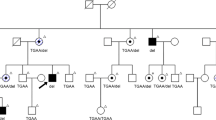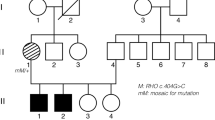Abstract
Objective
To investigate the usefulness of preimplantation genetic diagnosis (PGD) based on mutated allele revealed by sequencing with aneuploidy and linkage analyses (MARSALA) for a pedigree with X-linked retinitis pigmentosa (XLRP).
Methods
One pathogenic mutation (c.494G > A) of the retinitis pigmentosa GTPase regulator (RPGR) gene was identified in a pedigree affected by XLRP. Then, PGD was carried out for the couple, of which the wife was an XLRP carrier. Three blastocysts were biopsied and then MARSALA was performed by next-generation sequencing (NGS). Prenatal diagnosis was also carried out to confirm the PGD results.
Results
Three blastocysts were all unaffected. Then, one of the embryos was chosen randomly to be transferred, and the pregnancy was acquired successfully. The results of prenatal diagnosis were consistent with the PGD results. The fetus did not carry RPGR mutation (c.494G > A) and had normal chromosome karyotype. As a result, a healthy baby free of XLRP condition was born.
Conclusion
The PGD method based on MARSALA was established and applied to a family with XLRP successfully. MARSALA will be a valid tool, not only for XLRP families but also for families affected with other monogenetic disorders, to prevent transmission of the genetic disease from parents to offspring.




Similar content being viewed by others
References
Hamel C. Retinitis pigmentosa. Orphanet J Rare Dis. 2006;1:40.
Ali MU, Rahman MSU, Cao J, Yuan PX. Genetic characterization and disease mechanism of retinitis pigmentosa; current scenario. 3 Biotech. 2017;7(4):251.
Anasagasti A, Irigoyen C, Barandika O, López de Munain A, Ruiz-Ederra J. Current mutation discovery approaches in retinitis pigmentosa. Vis Res. 2012;75:117–29.
Murga-Zamalloa C, Swaroop A, Khanna H. Multiprotein complexes of retinitis pigmentosa GTPase regulator (RPGR), a ciliary protein mutated in X-linked retinitis pigmentosa (XLRP). Adv Exp Med Biol. 2010;664:105–14.
Megaw RD, Soares DC, Wright AF. RPGR: its role in photoreceptor physiology, human disease, and future therapies. Exp Eye Res. 2015;138:32–41.
Handyside AH, Kontogianni EH, Hardy K, Winston RM. Pregnancies from biopsied human preimplantation embryos sexed by Y-specific DNA amplification. Nature. 1990;344(6268):768–70.
Heijligers M, van Montfoort A, Meijer-Hoogeveen M, Broekmans F, Bouman K, Homminga I, et al. Prenatal follow-up of children born after preimplantation genetic diagnosis between 1995 and 2014. J Assist Reprod Genet. 2018;35:1995–2002. https://doi.org/10.1007/s10815-018-1286-2.
Poulton A, Lewis S, Hui L, Halliday JL. Prenatal and preimplantation genetic diagnosis for single gene disorders: a population-based study from 1977 to 2016. Prenat Diagn. 2018;38:904–10. https://doi.org/10.1002/pd.5352.
Yan L, Huang L, Xu L, Huang J, Ma F, Zhu X, et al. Live births after simultaneous avoidance of monogenic diseases and chromosome abnormality by next-generation sequencing with linkage analyses. Proc Natl Acad Sci U S A. 2015;112(52):15964–9.
Ren Y, Zhi X, Zhu X, Huang J, Lian Y, Li R, et al. Clinical applications of MARSALA for preimplantation genetic diagnosis of spinal muscular atrophy. J Genet Genomics. 2016;43(9):541–7.
Vendrell X, Bautista-Llácer R, Alberola TM, García-Mengual E, Pardo M, Urries A, et al. Pregnancy after PGD for recessive dystrophic epidermolysis bullosa inversa: genetics and preimplantation genetics. J Assist Reprod Genet. 2011;28(9):825–32.
Borgulova I, Putzova M, Soldatova I, Krautova L, Pecnova L, Mika J, et al. Preimplantation genetic diagnosis of X-linked diseases examined by indirect linkage analysis. Bratisl Lek Listy. 2015;116(9):542–6.
Dreesen J, Destouni A, Kourlaba G, Degn B, Mette WC, Carvalho F, et al. Evaluation of PCR-based preimplantation genetic diagnosis applied to monogenic diseases: a collaborative ESHRE PGD consortium study. Eur J Hum Genet. 2014;22(8):1012–8.
Wilton L, Thornhill A, Traeger-Synodinos J, Sermon KD, Harper JC. The causes of misdiagnosis and adverse outcomes in PGD. Hum Reprod. 2009;24(5):1221–8.
Altarescu G, Zeevi DA, Zeligson S, Perlberg S, Eldar-Geva T, Margalioth EJ, et al. Familial haplotyping and embryo analysis for preimplantation genetic diagnosis (PGD) using DNA microarrays: a proof of principle study. J Assist Reprod Genet. 2013;30(12):1595–603.
Zheng Z, Zhao X, Xu B, Yao N. What should we focus on before preimplantation genetic diagnosis/screening. Arch Med Sci. 2018;14(5):1119–24.
Li G, Niu W, Jin H, Xu J, Song W, Guo Y, et al. Importance of embryo aneuploidy screening in preimplantation genetic diagnosis for monogenic diseases using the karyomap gene chip. Sci Rep. 2018;8(1):3139.
Zhang L, Wei D, Zhu Y, Gao Y, Yan J, Chen ZJ. Rates of live birth after mosaic embryo transfer compared with euploid embryo transfer. J Assist Reprod Genet. 2018;36:165–72. https://doi.org/10.1007/s10815-018-1322-2.
Handyside AH, Harton GL, Mariani B, Thornhill AR, Affara N, Shaw MA, et al. Karyomapping: a universal method for genome wide analysis of genetic disease based on mapping crossovers between parental haplotypes. J Med Genet. 2010;47(10):651–8.
Wu H, Shen X, Huang L, Zeng Y, Gao Y, Shao L, et al. Genotyping single-sperm cells by universal MARSALA enables the acquisition of linkage information for combined pre-implantation genetic diagnosis and genome screening. J Assist Reprod Genet. 2018;35(6):1071–8.
Acknowledgements
We thank the family for their participation in this study.
Funding
This work was supported by the Natural Science Foundation of Fujian Province, China (No. 2016J01589, No. 2018J01348).
Author information
Authors and Affiliations
Corresponding author
Ethics declarations
The couple signed informed consent forms for ICSI treatment, PGD, and follow-up. The protocols for this study were evaluated and approved by the Ethics Committee of Fuzhou General Hospital.
Conflict of interest
The authors declare that they have no conflict of interest.
Additional information
Publisher’s note
Springer Nature remains neutral with regard to jurisdictional claims in published maps and institutional affiliations.
Rights and permissions
About this article
Cite this article
Huang, X., Liu, Y., Yu, X. et al. The clinical application of preimplantation genetic diagnosis for X-linked retinitis pigmentosa. J Assist Reprod Genet 36, 989–994 (2019). https://doi.org/10.1007/s10815-019-01434-9
Received:
Accepted:
Published:
Issue Date:
DOI: https://doi.org/10.1007/s10815-019-01434-9




